Retrieval of Surface Air Specific Humidity Over the Ocean Using AMSR-E Measurements
Abstract
:1. Introduction
2. Data
3. Development of the new algorithm
4. Comparison with global buoy data
5. Discussions
6. Summary
Acknowledgments
References and Notes
- Schulz, J.; Schlüssel, P.; Grassl, H. Water vapor in the atmospheric boundary layer over oceans from SSM/I measurements. Int. J. Remote Sens. 1993, 14, 2773–2789. [Google Scholar]
- Schlüssel, P.; Schanz, L.; Englisch, G. Retrieval of latent heat flux and longwave irradiance at the sea surface from SSM/I and AVHRR measurements. Adv. Space Res. 1995, 16, 107–116. [Google Scholar]
- Chou, S.H.; Atlas, R.M.; Shie, C.L.; Ardizzone, J. Estimates of Surface Humidity and Latent Heat Fluxes over Oceans from SSM/I Data. Mon. Weather Rev. 1995, 123, 2405–2425. [Google Scholar]
- Kubota, M.; Iwasaka, N.; Kizu, S.; Konda, M.; Kutsuwada, K. Japanese Ocean Flux Data Sets with Use of Remote Sensing Observations (J-OFURO). J. Oceanogr. 2002, 58, 213–225. [Google Scholar]
- Chou, S.H.; Nelkin, E.; Ardizzone, J.; Atlas, R.M.; Shie, C.L. Surface turbulent heat and momentum fluxes over global oceans based on the Goddard Satellite retrievals, version 2 (GSSTF2). J. Climate 2003, 16, 3256–3273. [Google Scholar]
- Grassl, H.; Jost, V.; Kumar, R.; Schulz, J.; Bauer, P.; Schluessel, P. The Hamburg Ocean-Atmosphere Parameteres and Fluxes from Satellite Data (HOAPS): A climatological atlas of satellite-derived air-sea-interaction parameters over the oceans; Report No. 312; Max Planck Institute for Meteorology: Hamburg, Germany, 2000. [Google Scholar]
- Zong, H.; Liu, Y.; Rong, Z.; Cheng, Y. Retrieval of sea surface specific humidity based on AMSR-E satellite data. Deep-Sea Res. Part I 2007, 54, 1189–1195. [Google Scholar]
- Yu, I.; Weller, R.A.; Sun, B. Mean and variability of the WHOI daily latent and sensible heat fluxes at in situ flux measurement sites in the Atlantic Ocean. J. Climate 2004, 17, 2096–2118. [Google Scholar]
- Jiang, C.L.; Cronin, M.F.; Kelly, K.A.; Thompson, L. Evaluation of a hybrid satellite- and MWP-based turbulent heat flux product using Tropical Atmosphere-Ocean (TAO) buoys. J. Geophys. Res.-Oceans 2005, 110, C09007. [Google Scholar] [CrossRef]
- Kalnay, E.C.; Kanamitsu, M.; Kistler, R.; Collins, W.; Deaven, D.; Gandin, L.; Iredell, M.; Saha, S.; White, G.; Woollen, J.; Zhu, Y.; Leetmaa, A.; Reynolds, B.; Chelliah, M.; Ebisuzaki, W.; Higgins, W.; Janowiak, J.; Mo, K.C.; Ropelewski, C.; Wang, J.; Jenne, R.; Joseph, Dennis. The NCEP/NCAR 40-Year Re-analysis Project. B. Am. Meteorol. Soc. 1996, 77, 437–441. [Google Scholar]
- Gulev, S.; Jung, T.; Ruprecht, E. Estimation of the impact of sampling errors in the VOS observations on air-sea fluxes. Part I: Uncertainties in climate means. J. Climate 2007, 20, 279–301. [Google Scholar]
- Fairall, C.W.; Bradley, E.F.; Hare, J.E.; Grachev, A.A.; Edson, J.B. Bulk parameterization of air-sea fluxes: Updates and verification for the COARE algorithm. J. Climate 2003, 16, 571–591. [Google Scholar]
- Kubota, M.; Iwabe, N.; Cronin, M. F.; Tomita, H. Surface heat fluxes from the NCEP/NCAR and NCEP/DOE reanalyses at the Kuroshio Extension Observatory buoy site. J. Geophys. Res. -Oceans 2008, 113, C02009. [Google Scholar] [CrossRef]
- Meindl, E.A.; Hamilton, G.D. Programs of the National Data Buoy Center. B. Am. Meteorol. Soc. 1992, 73, 985–993. [Google Scholar]
- McPhaden, M.J.; Delcroix, T.; Hanawa, K.; Kuroda, Y.; Meyers, G.; Picaut, J.; Swenson, M. The El Nino/Southern Oscillation (ENSO) Observing System, Observing the Ocean in the 21st Century; Australian Bureau of Meteorology: Melbourne, Australia, 2001; pp. 231–246. [Google Scholar]
- Liu, W.T. Statistical relation between monthly mean precipitable water and surface-level humidity over global ocean. Mon. Weather Rev. 1986, 14, 1591–1602. [Google Scholar]
- Wilks, D.S. Statistical methods in the atmospheric sciences, Second edition; Academic Press: New York, 2006. [Google Scholar]
- Bentamy, A.; Katsaros, K.B.; Mestas-Nuñez, A.M.; Drennan, W.M.; Forde, E.B.; Roquet, H. Satellite estimates of wind speed and latent heat flux over the global oceans. J. Climate 2003, 16, 637–656. [Google Scholar]
- Singh, R.; Simon, B.; Joshi, P.C. A technique for direct retrieval of surface specific humidity over open oceans from IRS-P4/MSMR satellite. Bound.-Lay. Meteorol. 2003, 106, 547–559. [Google Scholar]
- Jackson, D.L.; Wick, G.A.; Bates, J.J. Near-surface retrieval of air temperature and specific humidity using multisensor microwave satellite observations. J. Geophys. Res.-Atmos. 2006, 111(D10306). [Google Scholar] [CrossRef]
- Kubota, M.; Tomita, H. The Present State of the J-OFURO Air-Sea Interaction Data Product. Flux News 2008, 4, 13–15. [Google Scholar]
- Kanamitu, M.; Ebisuzaki, W.; Woolen, J.; Yang, S.K.; Hnilo, J.J.; Fiorino, M.; Potter, G.L. NCEP-DOE AMIP-II (R-2). B. Am. Meteorol. Soc. 2002, 83, 1631–1643. [Google Scholar]
- Onogi, K.; Tsutsui, J.; Koide, H.; Sakamoto, M.; Kobayashi, S.; Hatsushita, H.; Matsumoto, T.; Yamazaki, N.; Kamahori, H.; Takahashi, K.; Kadokura, S.; Wada, K.; Kato, K.; Oyama, R.; Ose, T.; Mannoji, N.; Taira, R. The JRA-25 reanalysis. J. Meteorol. Soc. Jpn. 2007, 85, 369–432. [Google Scholar]
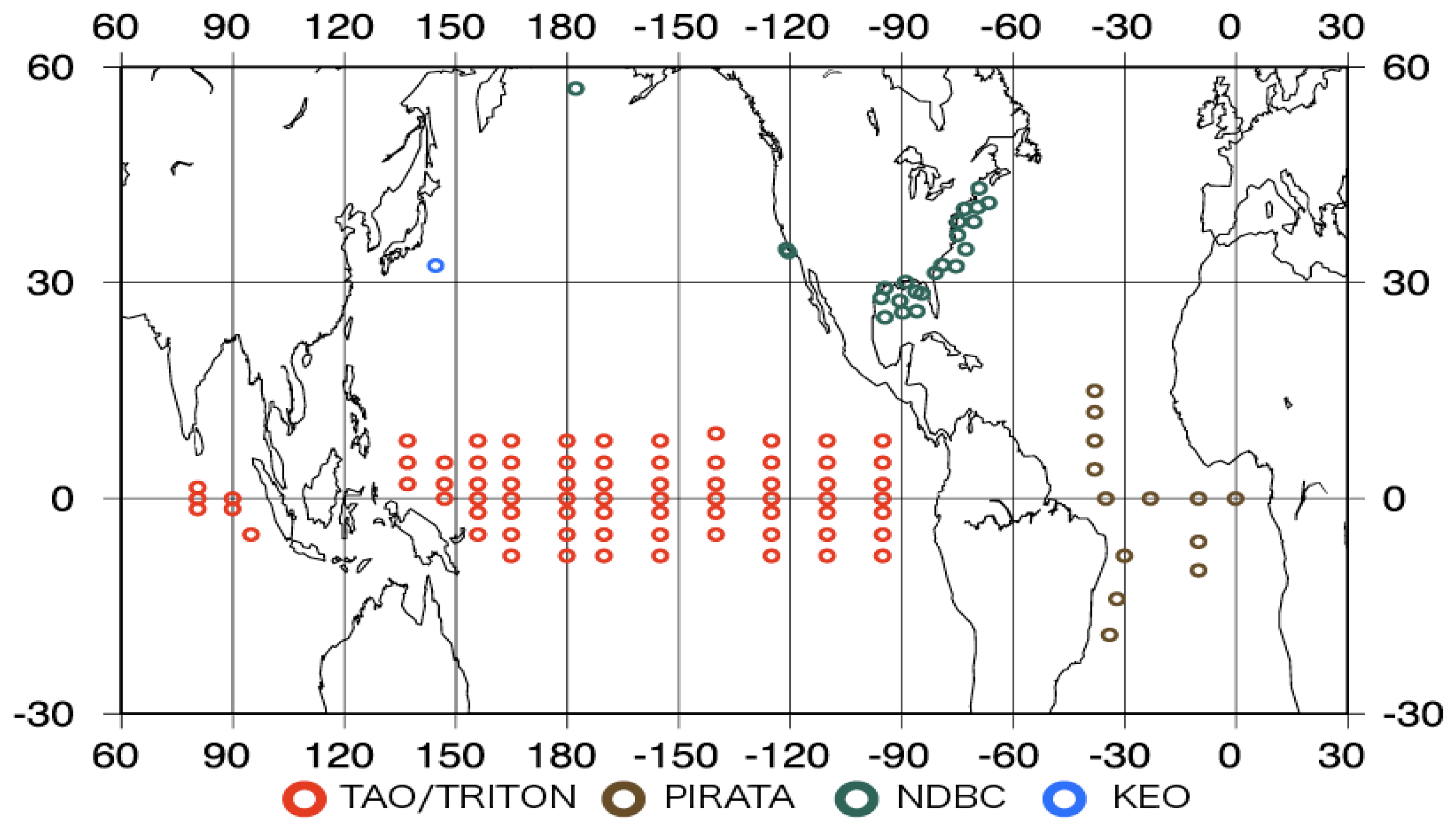
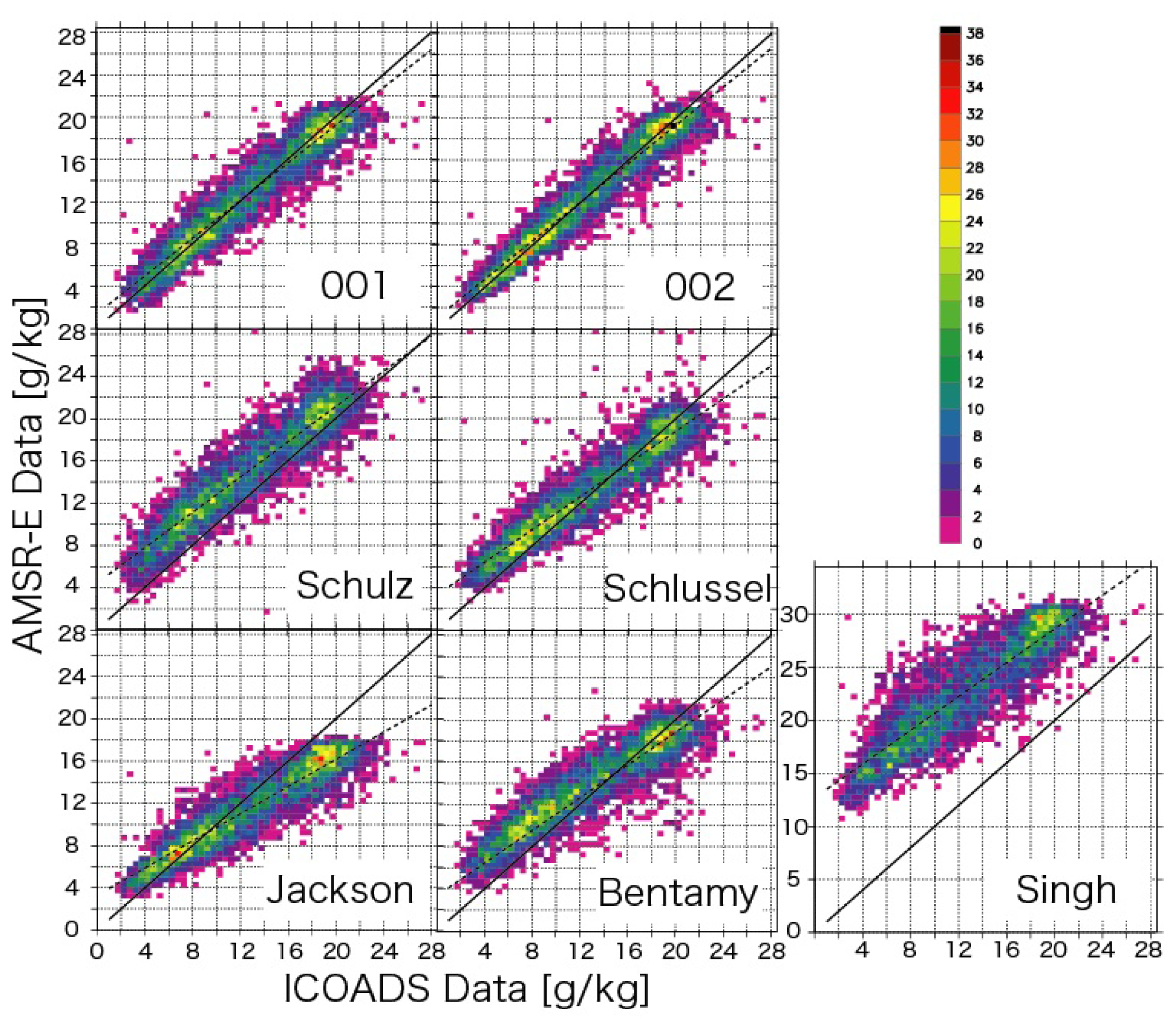
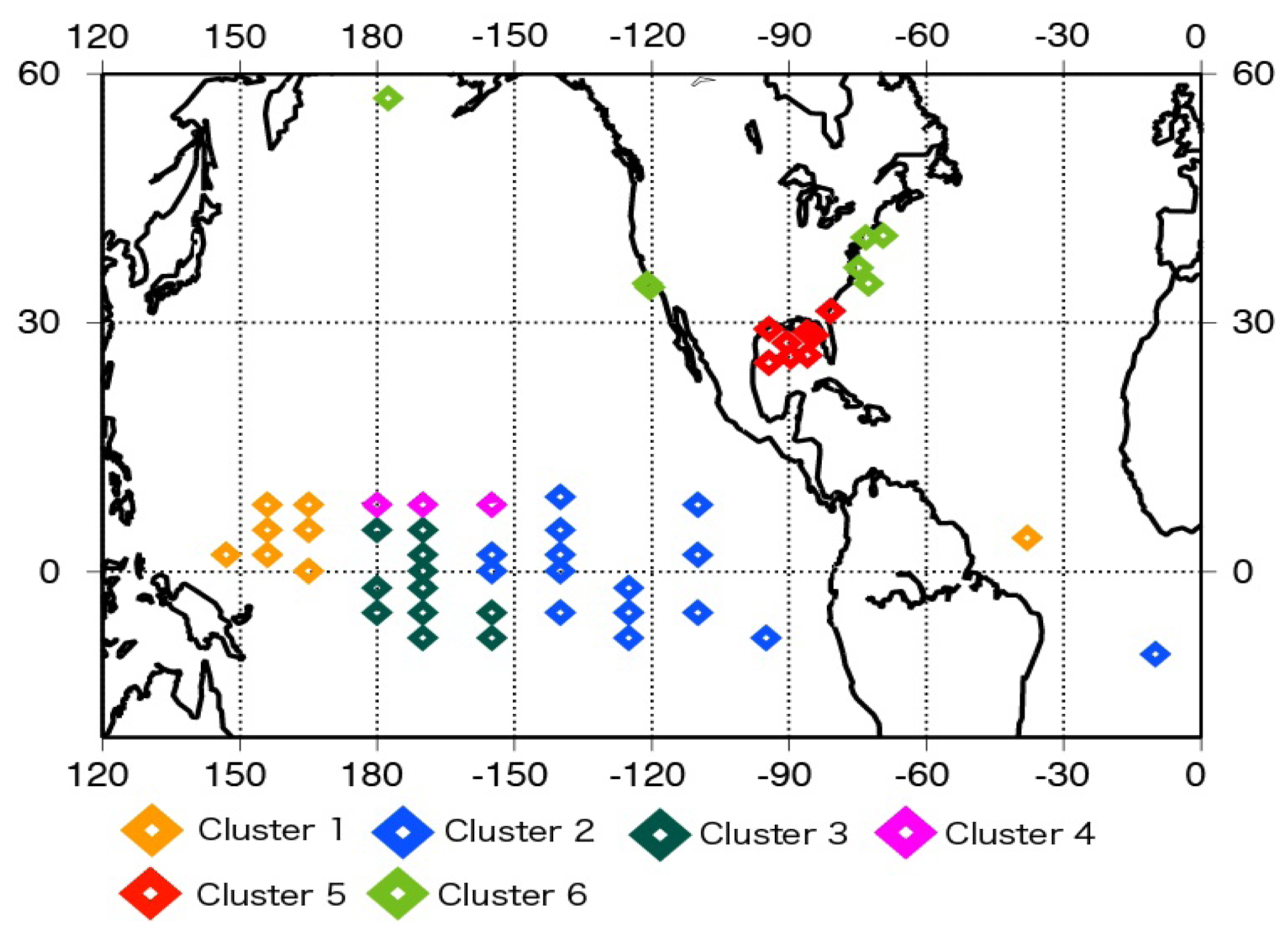
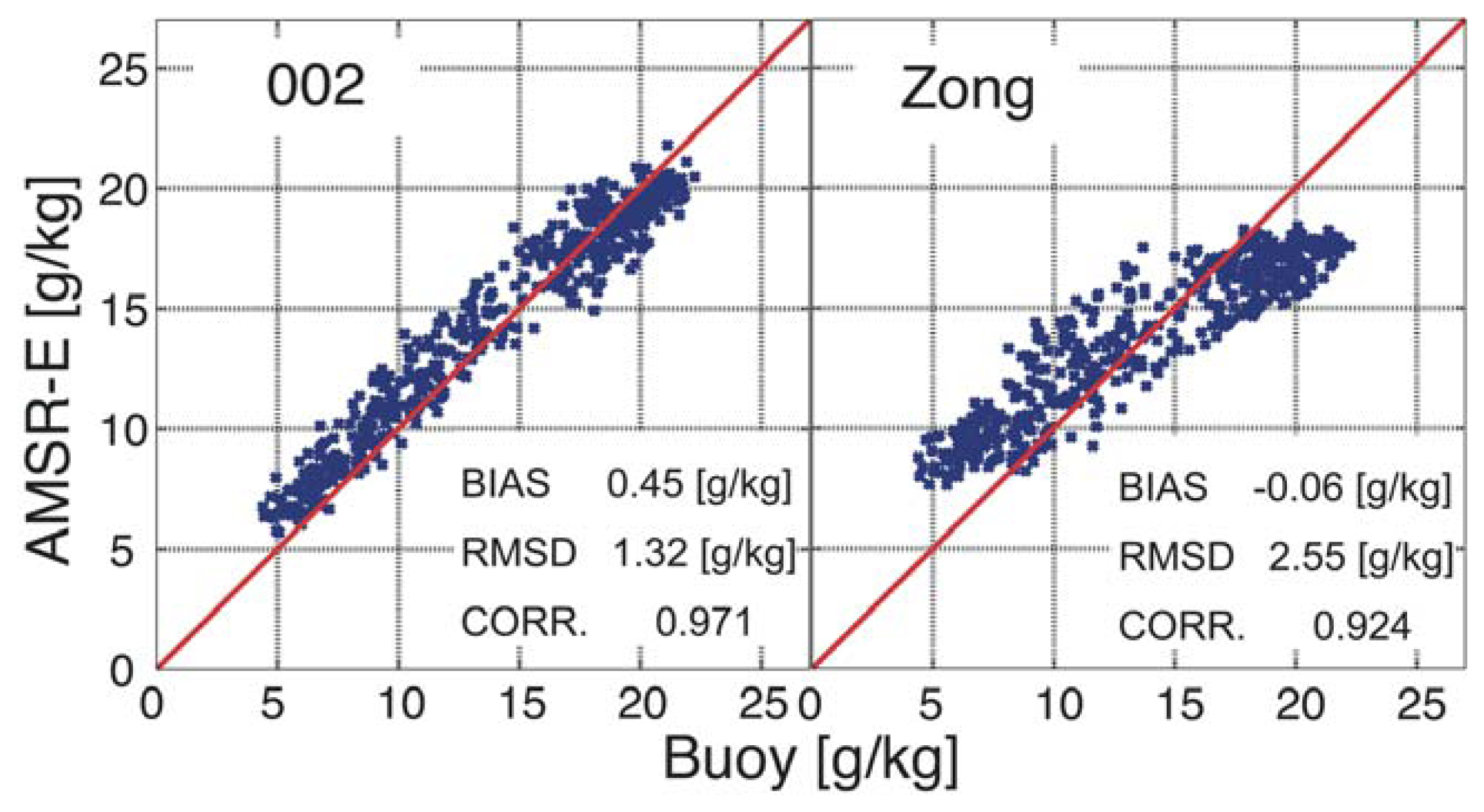
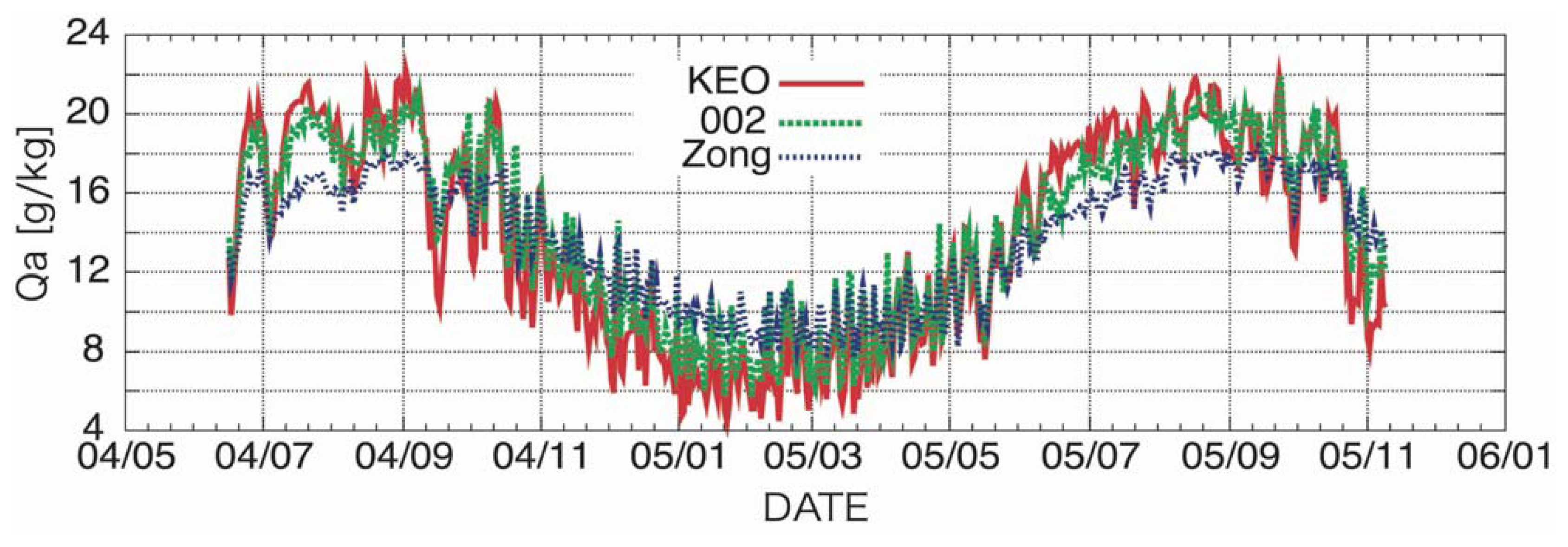
| a0 | a1 | a2 | a3 | a4 | a5 | a6 | |
|---|---|---|---|---|---|---|---|
| 001 | -92.775 | 0.092 | -0.067 | 0.199 | -0.181 | -0.259 | 0.310 |
| 002 | -49.324 | -0.003 | 0.001 | 0.136 | -0.104 | -0.118 | 0.127 |
| a7 | a8 | a9 | a10 | a11 | a12 | a13 | |
| 001 | 1.451 | -0.680 | -0.908 | 0.316 | 0.173 | -0.068 | |
| 002 | 0.812 | -0.381 | -0.524 | 0.202 | 0.099 | -0.047 | 0.555 |
| 001 | df | SS | MS | F (=MSR/MSE) |
|---|---|---|---|---|
| Total | 5,626 | 170,096 | ||
| Regression | 12 | 155,117 | 12,926 (MSR) | 4,845 |
| Residual | 5,614 | 14,979 | 2.67(MSE) | |
| 002 | Df | SS | MS | F |
| Total | 5,626 | 170,096 | ||
| Regression | 13 | 158,229 | 12,171 (MSR) | 5,946 |
| Residual | 5,613 | 11,450 | 2.05(MSE) | |
| 001 | 002 | Schulz | ||
|---|---|---|---|---|
| BIAS [g/kg] | -0.01 | -0.03 | 2.32 | |
| RMSE [g/kg] | 1.75 | 1.57 | 2.17 | |
| CORRELATION | 0.946 | 0.957 | 0.916 | |
| Schlussel | Bentamy | Singh | Jackson | |
| BIAS [g/kg] | 0.45 | 0.89 | 10.12 | -1.25 |
| RMSE [g/kg] | 2.17 | 2.46 | 2.65 | 2.48 |
| CORRELATION | 0.919 | 0.903 | 0.872 | 0.912 |
| 001 | 002 | J-OFURO2 | HOAPS3 | ||
|---|---|---|---|---|---|
| BIAS [g/kg] | 0.46 | 0.38 | 0.19 | -0.21 | |
| RMSE [g/kg] | 1.23 | 1.01 | 1.68 | 1.57 | |
| CORRELATION | 0.954 | 0.970 | 0.920 | 0.925 | |
| Zong | Liu | NRA1 | NRA2 | JRA25 | |
| BIAS [g/kg] | -0.41 | 0.03 | 0.72 | 0.39 | 0.67 |
| RMSE [g/kg] | 1.65 | 1.88 | 1.13 | 1.16 | 0.95 |
| CORRELATION | 0.923 | 0.906 | 0.962 | 0.959 | 0.973 |
| 001 | 002 | J-OFURO2 | HOAPS3 | ||
|---|---|---|---|---|---|
| BIAS [g/kg] | 0.48 | 0.38 | 0.20 | -0.20 | |
| RMSE [g/kg] | 0.80 | 0.61 | 1.17 | 1.15 | |
| CORRELATION | 0.985 | 0.992 | 0.967 | 0.971 | |
| Zong | Liu | NRA1 | NRA2 | JRA25 | |
| BIAS [g/kg] | -0.28 | 0.04 | 0.71 | 0.43 | 0.83 |
| RMSE [g/kg] | 1.31 | 1.18 | 0.72 | 0.77 | 0.58 |
| CORRELATION | 0.967 | 0.967 | 0.987 | 0.985 | 0.993 |
© 2008 by the authors; licensee Molecular Diversity Preservation International, Basel, Switzerland. This article is an open-access article distributed under the terms and conditions of the CreativeCommons Attribution license (http://creativecommons.org/licenses/by/3.0/).
Share and Cite
Kubota, M.; Hihara, T. Retrieval of Surface Air Specific Humidity Over the Ocean Using AMSR-E Measurements. Sensors 2008, 8, 8016-8026. https://doi.org/10.3390/s8128016
Kubota M, Hihara T. Retrieval of Surface Air Specific Humidity Over the Ocean Using AMSR-E Measurements. Sensors. 2008; 8(12):8016-8026. https://doi.org/10.3390/s8128016
Chicago/Turabian StyleKubota, Masahisa, and Tsutomu Hihara. 2008. "Retrieval of Surface Air Specific Humidity Over the Ocean Using AMSR-E Measurements" Sensors 8, no. 12: 8016-8026. https://doi.org/10.3390/s8128016




